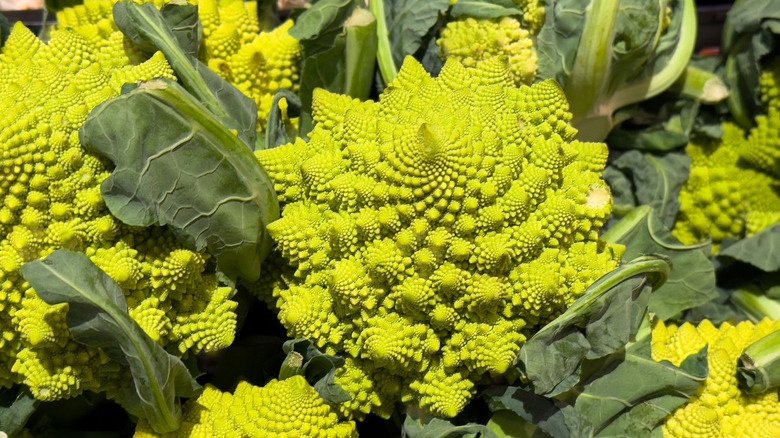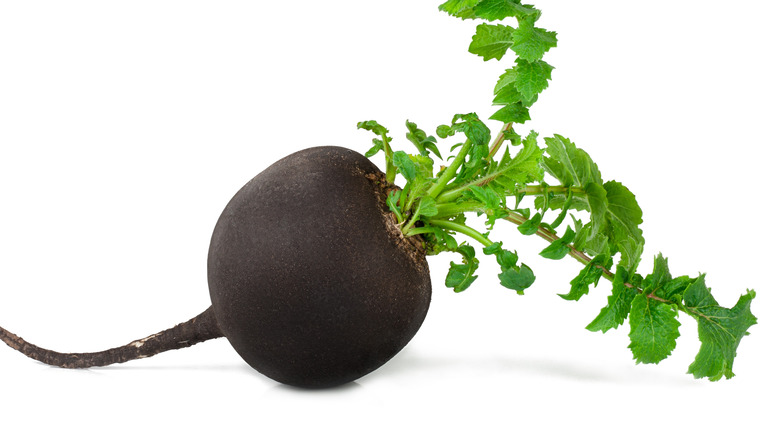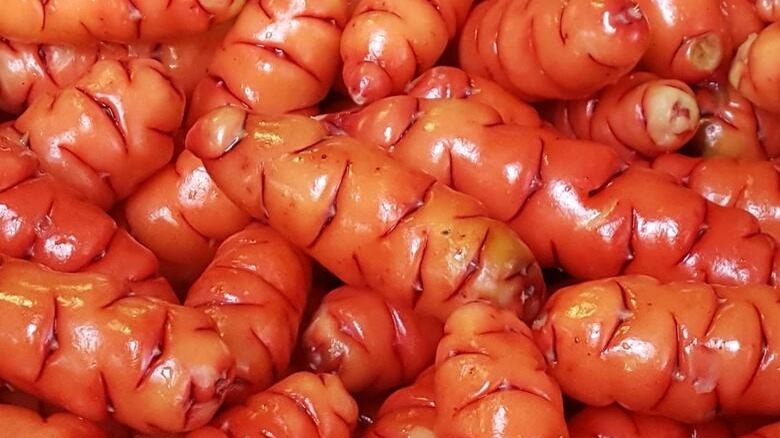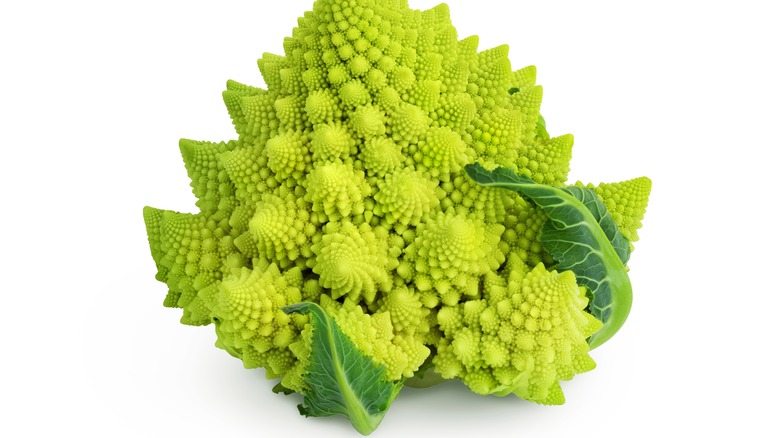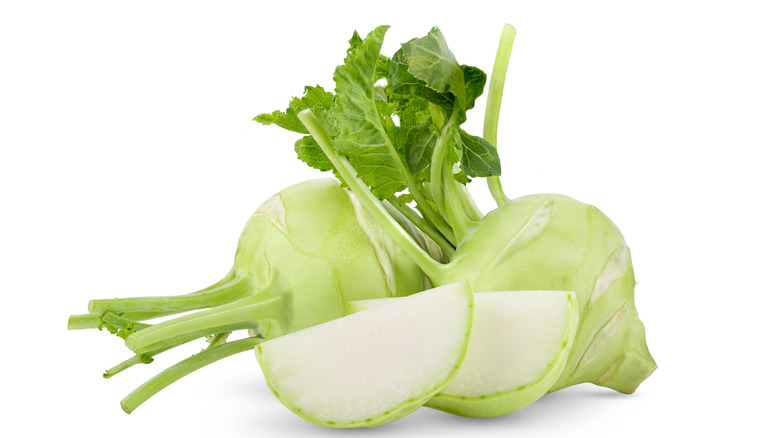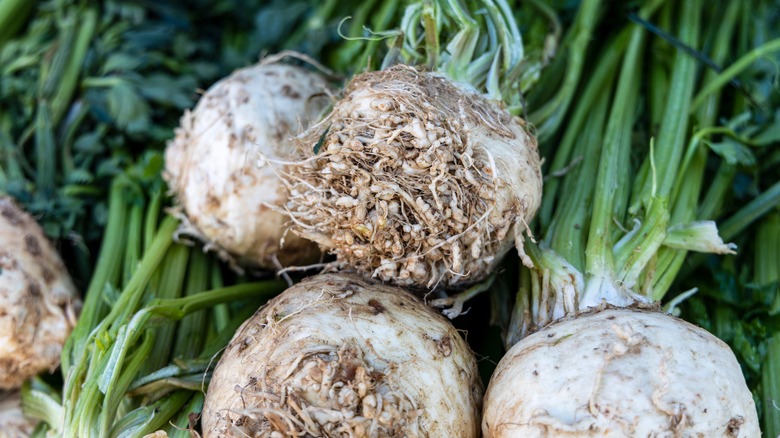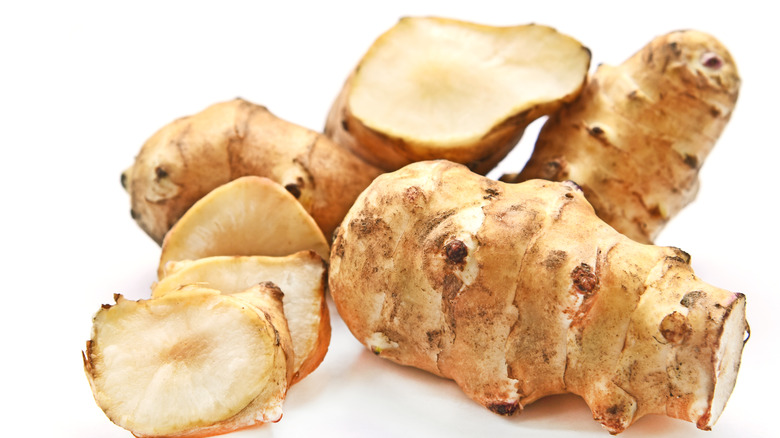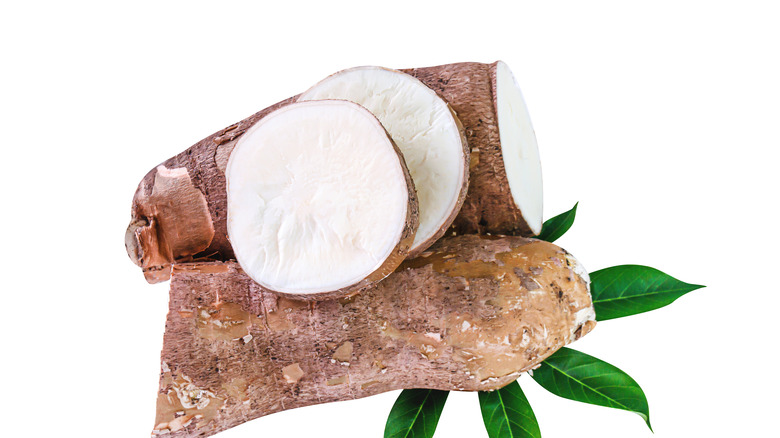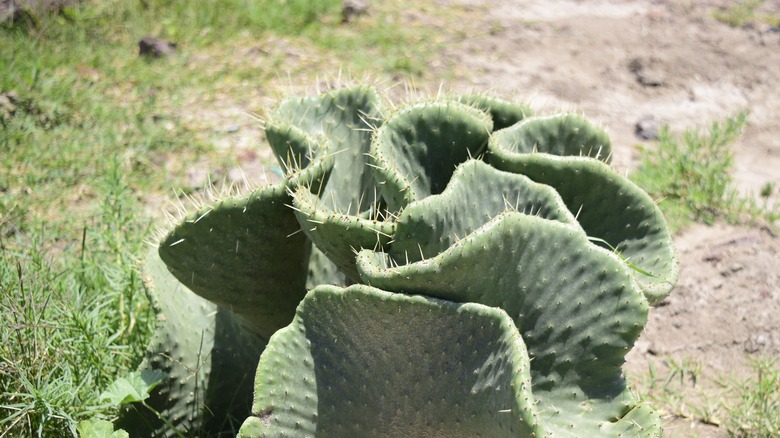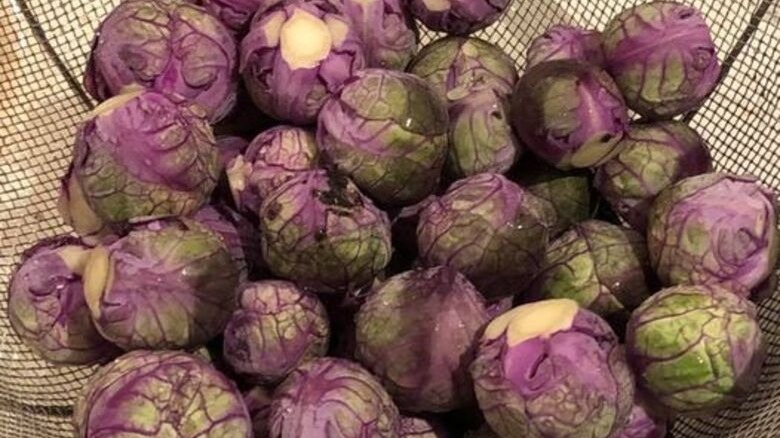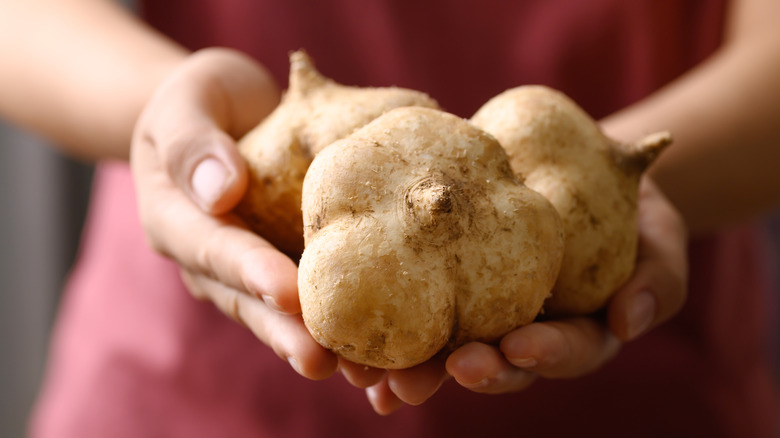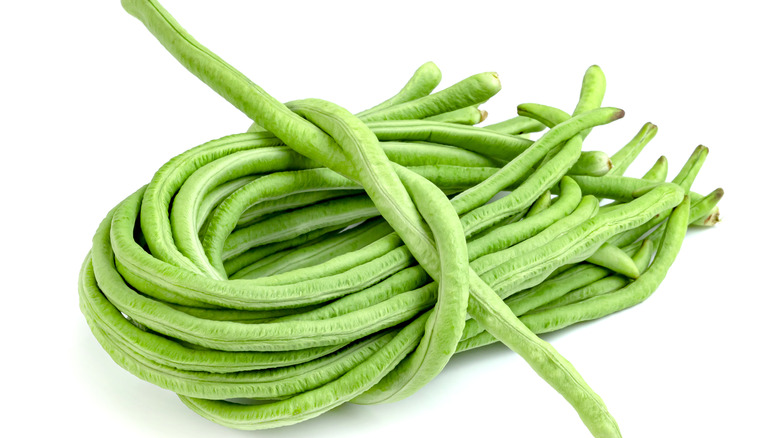11 Unique Vegetables You've Probably Never Heard Of
Move over, you boring, typical vegetables. Considering that there are 1,097 vegetable species worldwide, it's time to think outside the box and add more interesting varieties to your cooking routine (per Bioversity International). According to The Food and Agriculture Organization of the United Nations, species are becoming increasingly homogeneous – and most of us are only familiar with about 7% of them.
While these unique vegetables may not taste like your traditional cauliflowers, zucchinis, and broccolis, they are worth trying if you like variety. Furthermore, consuming a larger variety of vegetables can potentially help improve your heart health and your overall quality of life, per Nutrition Journal.
Best of all, these unique vegetables can open your mind and palate to new flavors and culinary experiences. We've included unique vegetables from around the world, some of which you may have encountered at your local grocery store, and assorted tips on cooking each veggie. So without further ado, let's start our global adventure of unique vegetables that will excite your taste buds.
Black Radish
Black radish goes by multiple names, including Spanish black radish and black mooli. They're available all year round and are related to broccoli, kale, and the like.
These delightful vegetables have two varieties. You'll either find round black radishes or an elongated version known as long black radish.
Both feature a rough, coarse, dusty black exterior, with creamy white flesh that is firm and crisp. Taste-wise, raw black radishes have a strong, pungent taste with sharp hints of spiciness and bitterness. When cooked, the flavor softens to a more palatable taste, with a sweet, peppery undertone that is easy to enjoy (via Specialty Produce).
Native to Asia and Europe, their history dates back to ancient times, when black radishes were not only popular as food, but were consumed for their medicinal properties. This is particularly true for ancient Egypt, where drawings depicted and deemed the vegetable holy and sacred (via Wholistic Matters). Black radishes were quite the thing in the Middle Ages. Their ability to withstand cold weather conditions and being nutrient-dense made them a staple for consumption during barren winters.
Toss them in a salad or cook them; black radishes are a sought-after veggie, primarily because of their ayurvedic medicinal properties. As per LiveStrong, the black radish has an abundance of glucosinolates, four times as many as any other vegetable. This compound is beneficial in detoxification of the liver, eradicating toxins from the body, and battling diabetes.
Oca
Oca tubers, also known as New Zealand Yams, are a less-popular alternative to potatoes and yams. They resemble potatoes but are more sweet and acidic. Oca was native to the high Andes and, after its spread, was consumed as a staple throughout South America.
This delicious vegetable traveled to Europe hoping to compete with potatoes but lost the battle. Conversely, when introduced to New Zealand, the hype caught on, and oca is still enjoyed today (via First Choice Produce). Andrew Zimmern describes this root vegetable as "very light and stunningly perfect for marriage with any roast or meal in a bowl. Very popular in New Zealand, deserves more use here in USA."
Oca can be eaten raw and cooked in a variety of dishes as well. They have a waxy exterior with indentions along the body. The golden flesh inside has a sour-lemony taste and releases a nuttier taste reminiscent of cooked potato, according to Specialty Produce. Oca, with its diverse flavor profile, is an excellent source of carbohydrates, vitamin C, potassium, iron, and protein.
These robust vegetables are typically grown in the autumn and gathered when the cold has cleared the path for harvest. But these vegetables take a long, long time to grow. Much like potatoes, oca is grown underground and can be stored for many months after it is harvested. A user on r/gardening Reddit, Alcleme1, claimed oca as a rare veggie, a "delicious tasting tuber" with a top that tastes lemony, like rhubarb.
Romanesco
Romanesco might be uncommon in your kitchen, but it is undoubtedly a rare beauty. This vibrant veggie is a cousin of cauliflower and broccoli and looks like them, too. Its deep vibrant green is perhaps the most attractive feature of this plant, not to mention each individual cone with its respective spikes. With its unique distended conical shape, this delicious vegetable is actually a flower harvested before it blooms and turns bitter.
Much like broccoli, romanesco has a warm, nutty taste with hints of sweetness. It has a crunchy exterior with earthy notes. The leafy greens are full of vitamins K and C, and are delicious when added to stews and soups, or eaten as an appetizer with a side of hummus (via Lake Winds).
According to Atlanta Magazine, you can eat romanesco raw. But if you prefer, you can steam it and toss it with pasta to make a healthy meal. When you cut the head into pieces, the little florets add allure to the plate, making even veggie-haters the ultimate fans.
Per the Village Voice, romanesco is a cultivar of broccoli hailing from central Italy. What's fascinating about it is not only that it looks like art or an alien life-form, but its fractals follow the Fibonacci sequence, a logarithmic pattern (via East Lansing Info). According to a user on Reddit, Platourne, you can cut this vegetable into little florets and use them in a hot or cold salad. They are also delicious when steamed or boiled.
Kohlrabi
Kohlrabi is a member of the cabbage family, kin to broccoli. It has a squid-like structure, a bulbous-round bottom with stems and leaves sprouting. Kohlrabi is best consumed in the summer and is an excellent absorber of flavors. When added to salads, this delicious veggie brings a refreshing element to the bowl. Its leaves and stems are typically stir-fried as a delicious side.
However, the bulb part is more commonly consumed. Bite into it raw and uncooked, and you'll be surprised to find a juicy, crisp texture. While it's delicious steamed, boiled, or roasted, serving it raw works just as well for many veggie lovers (via Wedge and Linden Hills Co-op).
Once you've stripped away the bitter-tasting layers of the bulb, you'll find the flavor profile to be reminiscent of its cousin vegetables but a tad bit spicier, like a radish. In German, the word "kohl" translates to cabbage and "rabi" to turnip. An apt translation, considering its flavors and looks are similar to these vegetables.
Kohlrabi has two color variants, purple and green. This root vegetable grows underground; only the spherical bulb manifests above the soil, and the stem lies buried in the dirt (via The Land Connection). According to HealthLine, kohlrabi is jam-packed with healthy nutrients, including vitamin C, fiber, and antioxidants. Consuming this veggie is known to improve gut health and fight against heart disease, so enjoy it to your heart's content.
Celeriac
There's more to celeriac than meets the eye. Sure, the vegetable looks gnarly and dirty, but once you get around celeriac's distinct appearance, there's a world of flavors lying beneath the skin.
This root vegetable has a knob-like structure, with protrusions on its body and leaves shooting up from the top of the head. But it makes up for this appearance by being a versatile veggie. According to the Great British Chefs, you can eat it raw and add it to salads. Raw celeriac has a crunchy texture with a nutty flavor that's refreshing to eat.
According to NPR, celeriac belongs to the family of carrots, anise, and parsley. It also goes by other names like root celery and knob celery. This odd-looking veggie was mentioned in Homer's Odyssey during 800 B.C., but it took its time to rise in importance, particularly during the Middle Ages.
While this hearty winter vegetable is relatively unheard of in the States, it is quite the thing in Europe, where it shines as the star of the French salad: celeriac remoulade. The celeriac is peeled and grated and soaked in acidic water to bring out its flavor and maintain its color.
Celeriac is impressive in terms of its nutrient profile, loaded with nutrients like fiber, vitamins B6, C, and K, as well as potassium and antioxidants. This makes it the perfect veggie to consume for healthy bones, as well as a healthy heart (via Healthline).
Sunchoke
With looks like ginger and flavors similar to potato, sunchokes are a tuber root vegetable with unimpressive looks, but an aftertaste reminiscent of an artichoke. Their aliases include Jerusalem artichoke, sunroot, and earth apples.
The sunchoke is also known as a diabetic potato due to its high fiber, potassium, and inulin content. Though it is high in sugars, it has minimal to no effect on blood sugar levels. Sunchokes are known to improve gut health by regulating bowel function. Eating this tasty veggie also helps fight against cancer, decrease cholesterol levels, and regulate blood pressure (via Very Well Fit).
Sunchokes come from a variety of sunflowers. These veggies can be easily swapped with potatoes in most recipes, but since they have comparatively no starch, they are a tad different to cook with. Typical ways you can prepare them include roasting, boiling, baking, adding them to soups, or eating them raw in a salad (via Specialty Produce).
According to Lake Winds, these veggies grow in the wild. While they are sweet to taste and have a mild palatable flavor, they are crunchy in texture. Some would describe the flavor to be reminiscent of water chestnuts and hazelnuts. That's why they make for excellent tasty sun chips. A Reddit user suggests cutting them into two-bite chunks and seasoning them with olive oil, cayenne, pepper, and salt, then roasting them until they're tender.
Cassava
Cassava is another tuber root vegetable on this list of unique veggies. Native to South America, it is a drought-resistant plant that can thrive in the harshest weather. It is widely grown in Thailand and Nigeria and is considered a staple food in the tropical region due to its high calorie and carb content (via Healthline).
Other names of this veggie include manioc, tapioca, and yuca, according to Thought Co. As Healthline notes, cassava can be used as starch and as thickeners. Cassava is often turned into flour; people with food allergies can particularly benefit from its use in cooking or baking. What's more is that this veggie has a warm, nutty taste and sweet flavor with just a slight peppery hint.
Though it has healthy nutrients like resistant starch, it may pose a health danger, as it contains a chemical known as cyanogenic glycosides. If this flour is not properly treated, it can have fatal poisoning effects. One such incident was reported by the Centers For Disease Control and Prevention, whereby 33 individuals who consumed a cassava dish made with cassava flour and hot water were admitted due to cyanide poisoning. So it's better not to consume cassava untreated.
A Reddit user, kachungaz, claims that their favorite way to eat cassava is to boil and mash it with some salt and butter to make a delicious side dish. Or add it to other starchy veggies in stew or soup, like sancocho.
Nopales
To simplify it, nopales are the edible pads of a prickly pear cactus. Well, don't be put off by the thorny exterior; nopales are more popular than you'd realize.
Many Mexican dishes are served de nopal. The cactus is considered a life-giving plant, one whose rebirth cycle is reflected in ancient Mexican myths. It lives a long time, and when its leaves fall, they become more plants. To cook this plant, you need to harvest it when the leaves are light green, the thorns are peeled, and the base is discarded, per Surviving Mexico.
There are so many ways to prepare nopales. As Surviving Mexico suggests, you can cook the leaf entirely or cut it into small chunks and cook it up on a grill. You can boil it or serve it in salads with some yummy tomatoes, chili, and beans. Moreover, you can eat it like a tortilla with cheese; the possibilities are endless.
According to a user on Quora, Brian Hamilton, grilled nopales taste like a stronger version of string beans or French beans, while some people may claim the taste to be reminiscent of okra.
As per Healthline, nopales have several health benefits. They have antiviral properties and are good for heart health, cholesterol, and blood sugar levels. Additionally, they are loaded with antioxidants and a good source of calcium and vitamin C.
Brusselberry Sprouts
Imagine a cross between blueberries and sprouts. Brusselberry sprouts are a tastier, more attractive version of the average green sprouts.
Their leaves carry a purple to green color, with violet veins encapsulating them, making these veggies look like bright baby cabbages. Foodie or not, anyone is bound to be amazed by their colors.
These purple sprouts have a nutty and sweet flavor, with grassy or earthy undertones. Some may say they have a bittersweet aftertaste. Brusselberry sprouts can be cooked in a variety of manners and even swapped with green sprouts in many dishes and recipes. When cooked, they retain a mild purple color. You can fry, roast, or boil them — or eat them raw.
These sprouts are far less common than their green counterparts, owing to the low yield. And they even cook faster than the green ones. But one thing's for sure: They are full of healthy nutrients. They are super delicious, healthy vegetables offering a rich source of anthocyanin flavonoids with anti-inflammatory properties (via Specialty Produce). Each veggie brings a healthy dose of vitamins A, B6, C, and K to the table.
Brusselberry sprouts grow in cool climates, particularly in the fall and winter. Hitchcock Farms suggests cooking them in a cheesy casserole recipe. If you want to give your dish a great color with a crunchy texture, toss these sprouts in. Pair oven-roasted sprouts with pancetta and smoked bacon, and you have a delicious meal.
Jicama
Jicama, pronounced as HEE-kah-ma, is a root veggie native to Mexico. It has a hard bark of skin that houses a beautiful white, crisp, and juicy flesh. Jicama could be a love child of apples and potatoes, says Freshly.
According to Healthline, jicama's nutty and sweet flavor has been likened to that of water chestnut. It is also known as Mexican water chestnut, Mexican potato, and yam beans.
Jicama requires a year-round warm season to grow. The plant that produces jicama also makes toxic beans similar to that of lima beans. However, as Healthline notes, jicama is full of healthy essential nutrients. It is a calorie- and fiber-dense veggie with loads of vitamin C and antioxidants. This tasty vegetable should be consumed to keep your heart and gut happy and healthy.
According to the Rachael Ray Show, jicama is a great food served in salads, with dips, or with a side of hummus. A Reddit user, elijha, suggests cutting jicama into batons and serving it with a splash of lime and tajin. A simple but tasty snack for you to munch on. You can also use jicama as a tortilla replacement for healthy tacos.
Yard-Long Beans
Long beans are accessible all year round. They are small, edible peas that are light green in color and reside in their pods. Depending on the kind, they are 12 to 30 inches long and slender, with a pale to dark green tint. The crisp, delicate pods can be consumed raw or cooked.
According to Eating Expired, long beans can be chopped up and served uncooked in salads like French haricots verts. As a side dish, long beans can be steamed or sautéed. They may be included in stews and soups. More so than snap beans, long beans have a chewy, crunchy texture, and they taste similar to dried navy beans or asparagus.
Asparagus beans, yard long beans, Chinese peas, snake beans, dau gok, and bodi or boonchi are additional names for long beans. You can store them in zipped plastic bags in the refrigerator for two to three days.
For stir-frying, chop long beans into 1- to 2-inch-long bite-sized pieces. It is important to trim long beans before cooking. Long beans can be deep-fried, shallow-fried, sautéed, stewed, braised, and stir-fried.
Cook long beans for 20 minutes in a braising stock that contains garlic or onions, along with other vegetables and meats. Braising works best with long beans that are dark green. According to Harvest To Table, yard-long beans have a flavor that gets better as they cook; they also get firmer, chewier, and nuttier.
